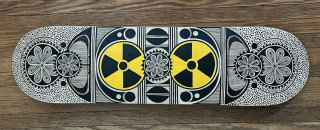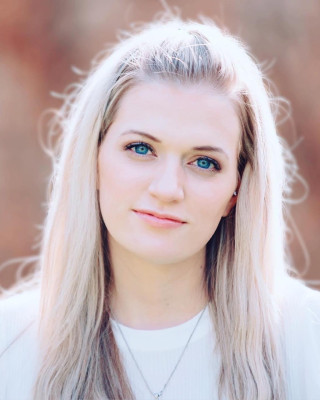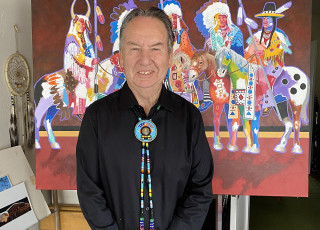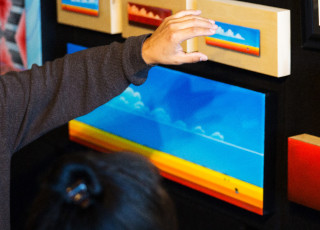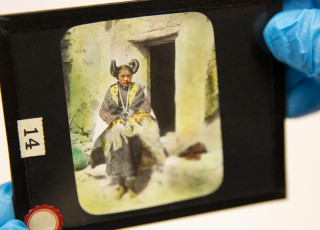NHMU 2024 Indigenous Art Market Acquisition: Rowan Harrison

Celebrating Native Artists
This article was published in celebration of NHMU's annual Indigenous Art Market & Festival — a vibrant two-day celebration of Native American art and culture. Get updated information about this year's celebration by following the link below.
By Olivia Barney
The Natural History Museum of Utah hosted their 11th annual Indigenous Art Market & Festival on October 12-13. The two-day event highlighted artwork in a multitude of mediums, crafted by some of the nation’s top Native American artists. The market, with its accompanying dance performances, talks, and ethnography collections showcase, is one of NHMU’s most anticipated yearly events. It draws large crowds of familiar faces — artists and attendees alike.
In addition to returning artists, the bustling market — held in the Museum’s Canyon — also hosted parents, children, and artists who were participating for the first time. It was an artist from the latter group who stood out: showcasing contemporary work, bold colors, and stark contrast. Visually, these pieces captured immediate attention — from the general public, as well as NHMU’s curatorial team, who decided the pieces were so unique, they should be added to the Museum’s permanent collections.
Each year, NHMU thoughtfully considers the pieces displayed at the Indigenous Art Market & Festival, identifying works that might fit within the Museum’s collection. This year, NHMU found the right fit in artist Rowan Harrison’s work, purchasing not one, but two of his pieces.
“As a curator, my goal is to add to our collection items that show cultural continuity with traditional art forms, but incorporate new styles and materials,” said NHMU's Curator of Ethnography, Alexandra Greenwald, Ph.D. “We have an endowed fund to support adding to our ethnographic collections, and we are thrilled when we find opportunities like this to build our ethnographic collection in ways that demonstrate contemporary cultural trends in Indigenous communities.”
Adding to our collection is always an exciting process, and we’re eager to show you the two pieces NHMU acquired from Harrison at the 2024 Indigenous Art Market & Festival.
Meet the Artist
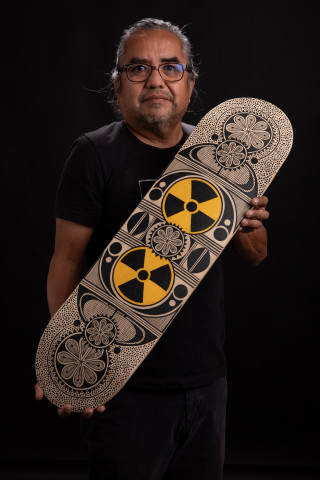
Artist Rowan Harrison. Photo by Mark Johnston
Rowan Harrison is a descendant of the Pueblo of Isleta on his mother’s side and Navajo on his father’s. Though he was raised in southern California, he spent the summers in New Mexico with his grandmother, Anita Abeita. It was there that he began his artistic journey. Making simple pinch pots or animal forms out of clay, he began to understand the beauty, versatility, and functionality of the material. He was raised by parents who proudly displayed their collection of traditional pottery throughout their home, giving Harrison a foundational appreciation of the art form.
This is where his artistic roots grew: in homes with his family and in the traditions they passed down.
Item #288
Harrison grew into his artistic identity, incorporating the elements of earth, water, air, and fire: precious resources for both beauty and function. His methods changed organically. New experiences shifted his perspective. New passions altered his preferred medium. As a young adult, Harrison started taking a mixed-media approach — recycling forgotten metal objects in his ceramic forms.
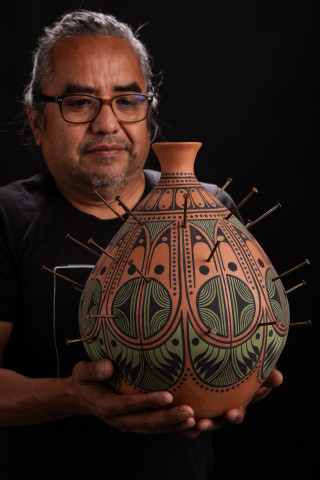
Photo by Mark Johnston
These pieces are experiments in stewardship, an effort to strike a balance between the natural and industrialized worlds. The first of NHMU’s latest acquisitions fits into this genre. Though simply titled, “Item #288” is made up of complex contradictions. The large vase was hand coiled using native-mined clay sourced directly from the Pueblo of Isleta. It was hand painted in colors that mimic the natural world. And yet, it is embedded with nails. It was fired in an electric kiln — born from an industrial era. Two worlds collide in Harrison’s exploration of balance, which is a masterful thought exercise that educates without casting judgment.
Radiation Skateboard
The second piece NHMU purchased from Harrison takes an even bolder approach to educating viewers by using a canvas that nods to an increasingly popular activity among Native communities: skateboarding. Skate culture provides opportunities for cultural and artistic expression among Native communities. This sport also acts as a method of connecting with other members of that community. Harrison’s use of a skateboard deck as a literal canvas for his art visually represents the artistic expression of skating.
“Radiation Skateboard” is a completely unique, freehand design. Using a natural maple-wood skateboard deck as his canvas, Harrison used acrylic paint and pen-and-ink illustrations to deliver a powerful message: a long history of uranium mining has continuing consequences.
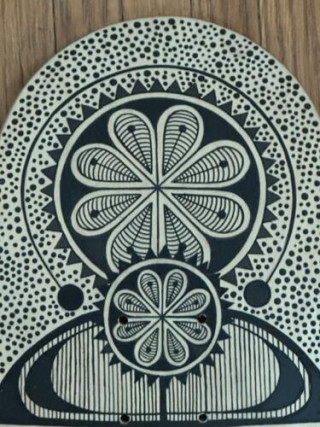
Detail of "Radiation Skateboard" by Rowan Harrison By Rowan Harrison
Harrison knew the general history. He was aware of the multi-generational effects of the now-abandoned uranium mines. But it wasn’t until recently that he fully realized their vast scope of impact.
Harrison recalled reading a study published in the Los Angeles Times, which tracked an alarming rise in cancer rates across Navajo people. The report connected these findings to the uranium mines that populated the southwest during the Cold War era. Harrison learned of approximately 500 abandoned mines built on or around Navajo land — close to homes.
Navajo men, who were hired to work the mines, returned to their homes in contaminated clothes, not knowing the risks. The contamination circulated in the air, spreading to the soil, livestock, and water tables. Without ever being inside a uranium mine, entire communities were exposed to the resulting radiation.
Harrison’s family has witnessed the effects of this exposure firsthand. He has a list of relatives who received a cancer diagnoses, six of which eventually died from the disease. His otherwise healthy family was disproportionately diagnosed. Uncles. Cousins. Grandparents. Eventually, his father. Harrison watched them all battle the illness.
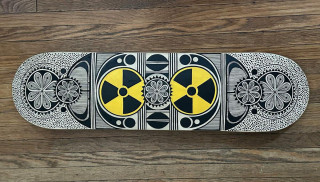
"Radiation Skateboard" By Rowan Harrison
Rowan’s Invitation
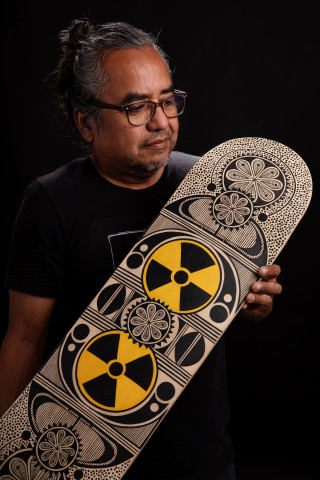
Photo by Mark Johnston
Since learning more about the way uranium mining disproportionately affects his people, Harrison has incorporated the trefoil (international symbol used for radiation warnings) into his art. His hope is to raise awareness, start a conversation, and see people become proactive in helping those who have been exposed.
Seeking the same balance explored in “Item #288,” “Radiation Skateboard” highlights the lingering effects of uranium mines on a unique, contemporary canvass — an effective showcase of how the past and present intersect. Using bold colors and natural materials, Harrison invites the world to hear, help, heal, and serve.
NHMU is excited to add these pieces to our collection and invites interested Native American artists to participate in our 12th annual Indigenous Art Market & Festival, which will take place in 2025. Until the market returns, visit our Native Voices exhibition to learn about Utah’s tribal communities and view their stunning art spanning the last hundred years. Entrance to Native Voices is included with regular admission, which is free for Museum Members and guests enrolled in federally or state-recognized tribes.
